


A classroom blog on contemporary art & new media in China, w focus on Shanghai. Run by students. Instructor: Defne Ayas (since '06), Francesca Tarocco (since '10). Past lecturers included: Yang Zhenzhong, Qiu Anxiong, Gu Wenda, Ding Yi, Hu Jieming, Birdhead, Zhao Chuan, Lynn Pan, Yang Fudong, Davide Quadrio, Jian Jun Zhang, Barbara Pollack, Lisa Movius, Phil Tinari, Li Zhenhua, Aaajiao, Shi Yong, Xu Zhen, Lorenz Helbling, Yan Pei Ming, ShuFu, Liu Ying Mei. Since Fall 2006.

 Upon first glance, Doland MOMA looks like a rectangular brick standing tall among the jagged houses that surround it. From a distance, the Doland MOMA shines a smooth layer of gray with a small section at the top of the building made of bright red steel and transparent glass. As we close in, the structured and quadrangle pattern compose and construct the Doland. The entrance is designed with the combination of black and red and only the black and red letters spelling Doland Shanghai Museum of Modern Art and a red street light compliment the connecting red and black design of the entrance. Simplicity is beauty, and Doland MOMA accentuates this exquisite aesthetic simplicity with its architectural sincerity. I favor the design of Doland over such other museums such as the Shanghai MOMA, the MOCA, and Zendai. The MOMA and MOCA are buildings refurbished and converted into modern art museums from their original architectural designs and purposes and this wanes their aesthetic and cultural objective. And although arguably MOCA and Zendai, with their attractive glass structure, I believe that art is not transparent, and the buildings should not illustrate this. Contemporary art is simple yet complex, a fusion of experience and imagination. It tries to portray truth through beauty and beauty within truth. The glass design of MOCA and Zendai do not convey the sense of this complex simplicity as well as Doland. From the architectural design of Doland’s combination of gray, red, black, and glass, the conveyance of contemporary art is much stronger. Doland’s gray tiles represent the intricate and complex composition of the materials to create the artwork. As we have seen, many contemporary artworks have a finalized product that we perceive to be a simple and candid reflection of life and truth; the earnest colors composing Doland’s structure accentuate these characteristics of contemporary art in its architecture.
Upon first glance, Doland MOMA looks like a rectangular brick standing tall among the jagged houses that surround it. From a distance, the Doland MOMA shines a smooth layer of gray with a small section at the top of the building made of bright red steel and transparent glass. As we close in, the structured and quadrangle pattern compose and construct the Doland. The entrance is designed with the combination of black and red and only the black and red letters spelling Doland Shanghai Museum of Modern Art and a red street light compliment the connecting red and black design of the entrance. Simplicity is beauty, and Doland MOMA accentuates this exquisite aesthetic simplicity with its architectural sincerity. I favor the design of Doland over such other museums such as the Shanghai MOMA, the MOCA, and Zendai. The MOMA and MOCA are buildings refurbished and converted into modern art museums from their original architectural designs and purposes and this wanes their aesthetic and cultural objective. And although arguably MOCA and Zendai, with their attractive glass structure, I believe that art is not transparent, and the buildings should not illustrate this. Contemporary art is simple yet complex, a fusion of experience and imagination. It tries to portray truth through beauty and beauty within truth. The glass design of MOCA and Zendai do not convey the sense of this complex simplicity as well as Doland. From the architectural design of Doland’s combination of gray, red, black, and glass, the conveyance of contemporary art is much stronger. Doland’s gray tiles represent the intricate and complex composition of the materials to create the artwork. As we have seen, many contemporary artworks have a finalized product that we perceive to be a simple and candid reflection of life and truth; the earnest colors composing Doland’s structure accentuate these characteristics of contemporary art in its architecture. In terms of the exterior architectural design, the entrance made from a combination of red and black epitomizes a multitude of meaning. It is this complex simplicity that I felt most impressed with. At first glance, one will only see the contrast between red and black; nothing special. However, after contemplation and examination, the basic design of the entrance symbolizes the cultural reference to Chinese cosmological belief. The strong belief that everything in this world is made of yin and yang, of a balance and integration of light and darkness symbolizes the inclusive and integrative nature of contemporary art. Like yin and yang, modern art is a representation between the balances of existential aspects in and around humanity that search and define truth. Also through the illustration of a modern cosmological reference, the museum seeks to indicate the cultural aspect.
In terms of the exterior architectural design, the entrance made from a combination of red and black epitomizes a multitude of meaning. It is this complex simplicity that I felt most impressed with. At first glance, one will only see the contrast between red and black; nothing special. However, after contemplation and examination, the basic design of the entrance symbolizes the cultural reference to Chinese cosmological belief. The strong belief that everything in this world is made of yin and yang, of a balance and integration of light and darkness symbolizes the inclusive and integrative nature of contemporary art. Like yin and yang, modern art is a representation between the balances of existential aspects in and around humanity that search and define truth. Also through the illustration of a modern cosmological reference, the museum seeks to indicate the cultural aspect. In terms of architectural design, Doland proudly exhibits many merits that place it at the forefront of Shanghai modern art and culture. It is the fruit of the effort, experience, and desire of the Chinese people to modernize and integrate themselves into the modern art world and exchange culture and individuality with the rest of the world for mutual progression. The one aspect that could be improved upon is the interaction and interconnection between the interior of Doland and the exterior environment. Doland’s walls completely seal and separate the interior with the exterior world. If instead of using concrete material to create the walls the designers used glass that is transparent from the inside but not observable from the outside, it would give contemporary art and the museum a mystic aura and allure audience in. Once inside, the audience may see and interpret the paintings as well as witness the world outside, which would symbolize an interpretative fusion of modern art and life: an experience of truth.
In terms of architectural design, Doland proudly exhibits many merits that place it at the forefront of Shanghai modern art and culture. It is the fruit of the effort, experience, and desire of the Chinese people to modernize and integrate themselves into the modern art world and exchange culture and individuality with the rest of the world for mutual progression. The one aspect that could be improved upon is the interaction and interconnection between the interior of Doland and the exterior environment. Doland’s walls completely seal and separate the interior with the exterior world. If instead of using concrete material to create the walls the designers used glass that is transparent from the inside but not observable from the outside, it would give contemporary art and the museum a mystic aura and allure audience in. Once inside, the audience may see and interpret the paintings as well as witness the world outside, which would symbolize an interpretative fusion of modern art and life: an experience of truth.


This exhibition is located at Bund 3, named ‘City in Progress / Live from Zhang Jiang’, a nonprofit Gallery. The size of the gallery is kind of small, embracing numerable art works; however, it is so decorated in details, even the identities on the wall or the simplified map painted on the floor from original map of Zhang Jiang. 
 The not commodious room nevertheless conveys to people a sense of void, as if the feeling generated from the developing industrial area of Zhang Jiang according to the topic. From the topic and the atmosphere emanated from the artists, we can conclude this exhibition is at the root of analysis of the conformation of the high-tech industrial area of Zhang Jiang, as a epitome of the industry area of China, relying on many kinds of expression, like TV, projector, or live imitation, interactively and artistically depicts the contemporary and future direction of the industry area of China.
The not commodious room nevertheless conveys to people a sense of void, as if the feeling generated from the developing industrial area of Zhang Jiang according to the topic. From the topic and the atmosphere emanated from the artists, we can conclude this exhibition is at the root of analysis of the conformation of the high-tech industrial area of Zhang Jiang, as a epitome of the industry area of China, relying on many kinds of expression, like TV, projector, or live imitation, interactively and artistically depicts the contemporary and future direction of the industry area of China. It can be said that it is a successful attempt to organically combine the area construction with creative mode of contemporary art. Zhangjiang is a special representative industry area in
It can be said that it is a successful attempt to organically combine the area construction with creative mode of contemporary art. Zhangjiang is a special representative industry area in 




 Yet another important gallery is that of Eastlink, located at 50 Moganshan Road, Building No. 6, fifth floor. Having opened in 1999, the gallery boasts 900 square meters of space, and is currently exhibiting “Extension Turn 2”, with works by a collection of international contemporary artists. One of the most striking currently on display is that of Johannes Speder, entitled “Mountain”. This work lies near the entrance to Eastlink, and occupies most of the front of the gallery. This captivating work lies across from another piece by He Yunchang entitled, “Beyond Mountains and the Sky”, a series of photographs detailing the artists attempt to use his own strength to push against the strength of an explosion. Eastlink is also featuring articles by seventeen different scientists in its catalogue, along with the twenty-seven participating artists. Eastlink also sells various antiques and past artwork in side rooms, to raise capital for its artistic endeavors. http://www.eastlinkgallery.cn/
Yet another important gallery is that of Eastlink, located at 50 Moganshan Road, Building No. 6, fifth floor. Having opened in 1999, the gallery boasts 900 square meters of space, and is currently exhibiting “Extension Turn 2”, with works by a collection of international contemporary artists. One of the most striking currently on display is that of Johannes Speder, entitled “Mountain”. This work lies near the entrance to Eastlink, and occupies most of the front of the gallery. This captivating work lies across from another piece by He Yunchang entitled, “Beyond Mountains and the Sky”, a series of photographs detailing the artists attempt to use his own strength to push against the strength of an explosion. Eastlink is also featuring articles by seventeen different scientists in its catalogue, along with the twenty-seven participating artists. Eastlink also sells various antiques and past artwork in side rooms, to raise capital for its artistic endeavors. http://www.eastlinkgallery.cn/ Finally, one should not finish their visit to Moganshan without stopping at ShanghART, located on 50 Moganshan Road, Buildings 16 & 18. Currently, the works of Zeng Fanzhi were on display, displaying his completely unique approach to art, with various works on display. The new exhibit, by Pu Jie, has been set to open on October 18th, and runs until October 31st. One can find more at http://www.shanghart.com/.Although some might feel that Moganshan has a feel of a slightly contrived space, especially in high-rise Shanghai, there is no disputing that the galleries there have no qualms about taking risks and pushing boundaries in China. A visit to Moganshan will not disappoint, and with around 100 galleries that are constantly changing exhibits, the scene here is never static. Moganshan sets the pace for the rest of the Shanghai art scene, and for those who want to see things before the move to the Shanghai MoCA or Zendai, Moganshan is the place to be.
Finally, one should not finish their visit to Moganshan without stopping at ShanghART, located on 50 Moganshan Road, Buildings 16 & 18. Currently, the works of Zeng Fanzhi were on display, displaying his completely unique approach to art, with various works on display. The new exhibit, by Pu Jie, has been set to open on October 18th, and runs until October 31st. One can find more at http://www.shanghart.com/.Although some might feel that Moganshan has a feel of a slightly contrived space, especially in high-rise Shanghai, there is no disputing that the galleries there have no qualms about taking risks and pushing boundaries in China. A visit to Moganshan will not disappoint, and with around 100 galleries that are constantly changing exhibits, the scene here is never static. Moganshan sets the pace for the rest of the Shanghai art scene, and for those who want to see things before the move to the Shanghai MoCA or Zendai, Moganshan is the place to be.
 For five weeks this autumn, the Serpentine Gallery will take up residence in Battersea Power Station The Power Station with a presentation of Chinese culture. This is the first chapter in an on-going series of exhibitions of contemporary Chinese art and architecture, organised by the Serpentine Gallery in collaboration with the Astrup Fearnley Museum of Mordern Art, Oslo.
For five weeks this autumn, the Serpentine Gallery will take up residence in Battersea Power Station The Power Station with a presentation of Chinese culture. This is the first chapter in an on-going series of exhibitions of contemporary Chinese art and architecture, organised by the Serpentine Gallery in collaboration with the Astrup Fearnley Museum of Mordern Art, Oslo.China Power Station: Part I is a unique opportunity to visit the iconic Battersea Power Station before it is redeveloped. It will also be the first chance to see the work of an extraordinary and vibrant new generation of Chinese artists and architects installed at this remarkable site.
Battersea Power Station echoes post-industrial art venues in China and the works on show have been chosen to activate the enormous scale of its spaces.  The exhibition will be filled with sound and moving images, arguably the most prolific and strongest type of work being created in China today.
The exhibition will be filled with sound and moving images, arguably the most prolific and strongest type of work being created in China today.  There are three floors to visit
There are three floors to visit
and the art will engage with each of these distinct areas. The unmissable and outstanding view from the third floor will offer a rare perspective of London. Two celebrated Chinese architects will define the space, demonstrating the potential of the building.
This is the Serpentine Gallery’s first large scale, off-site exhibition project. It will embrace and celebrate the power of the building as well as the buoyant developments in Chinese contemporary culture.
| Detail: Art Scene Warehouse's big space is bringing together the works of 16 of China's best photography artists. Some of the photographers, who come from throughout China, are among China's most famous and internationally exhibited, while others are young, emerging photography artists. The show is being co-curated by Gu Zheng, one of China's most respected photography curators. Gu curated the Guangzhou Photography Triennial in 2005, one of China's most important photography shows, as well as an exhibition that toured 4 USA museums in 2005 and 2006. |
FOREPLAY--Yang Zhenzhong Solo-Exhibition
Nov. 5th 2006– Nov.29th 2006
Opening Reception: Nov. 4th, 5.00-7.00 pm
ShanghART Gallery & H-Space is proud to present a solo-exhibition with
works by Yang Zhenzhong (b. 1968).
Using innovative techniques Yang Zhenzhong expands the credo that
‘underneath each picture there is always another picture’ into
‘underneath each picture there is always a specific medium’. The
exhibition FOREPLAY focuses on these mediating devices that constitute
the imagery of Yang Zhenzhongs exceptional work, whether it is video,
photography or installation art.
Yang Zhenzhong involves his audience in explorations intended to
generate visual effects and stimulate feelings and thoughts to bring
about unforeseen experiences and multiple points of view. FOREPLAY
provides an ample chance to view a practice that resists any specific
style, medium or material.
The desire to challenge normative notions and fixed formats of social
behavior informs the practices of Yang Zhenzhong’s work. He is
pre-occupied with a tendency to invert the order of things and often
touches upon taboos such as death and out-dated social norms.
His approach is metaphorical rather than narrative: His videos often
start from witty ideas, employing pictorial repetition and rhythmic
coordination of sound, language and image. Yang Zhenzhong became famous
in 2000 with his half-hour video “(I Know) I Will Die” that features
short sequences in which a series of people speak the phrase "I will
die" to the camera. It is a disconcerting, soberly presented film that
confronts the viewer with existential questions. Yang Zhenzhong
recognizes that individual participation is the starting point for the
transformation of perception. Another landmark video includes “Let’s
Puff” which premiered at the fourth Shanghai Biennale (2002) and the
50th Venice Biennale (2003). The video starts from the interplay of two
images: a young woman puffing and exhaling in a busy street. Every time
the woman breathes, the image of the street moves away from the viewer.
The rhythm of the traffic and the angle of perception are altered with
the rhythm of the woman’s breath. Consequently, the image is not fixed,
but remains in a state of change. Yang Zhenzhong’s playful videos are
more than visual reflections; they are intelligent comments on the
design of contemporary society
With a sincere attitude, but in a playful manner, the artist explores
the contemporary preoccupation with questions of identity and
perception, and the ability of images to turn apathy into anticipation,
and ordinariness into desirability. He uses part fiction and part
reality that tangles both the euphoric enthusiasm and deep anxiety of
day-to-day experience. His work has lately been described as “an
extraordinary distillation of an artistic practice that couldn’t be
more preoccupied with the nature of what is real”.
Born in Xiaoshan in 1968, Yang Zhenzhong now lives and works in
Shanghai. He graduated from the oil painting department of the
ChinaFineArtsAcademy in Hangzhou in 1993 and began working with video
and photography in 1995. Yang Zhenzhong’s work has showed at major
international exhibitions, biennales and triennials. Recent exhibitions
include China Contemporary – Art, Architecture and Visual Culture,
Museum Boiman van Beuningen, Rotterdam, The Netherlands (2006), Yang
Zhenzhong Solo-Exhibition, IKON Gallery, Birmingham, UK (2006), and
China Power Station – Part I, Battersea Power Station – The Serpentine
Gallery, London, UK (2006).
2006-10-10 18:21
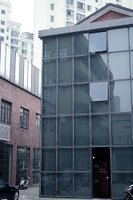

 Of the artworks that we witnessed, none astonished me more than the works produced by Zeng Fanzhi. With strong brushstrokes and dark colors, Zeng Fanzhi collides colors and canvas. Each stroke he slashes onto the canvas tears another wound of ghastly beauty that pulls the audience into the aesthetic turmoil. Beyond the individual chaos of every stroke, a ghoulish image emerges from the dark colors and rugged outlines.
Of the artworks that we witnessed, none astonished me more than the works produced by Zeng Fanzhi. With strong brushstrokes and dark colors, Zeng Fanzhi collides colors and canvas. Each stroke he slashes onto the canvas tears another wound of ghastly beauty that pulls the audience into the aesthetic turmoil. Beyond the individual chaos of every stroke, a ghoulish image emerges from the dark colors and rugged outlines. 
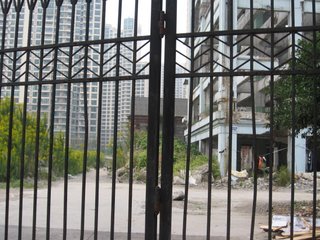
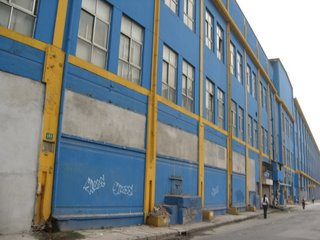

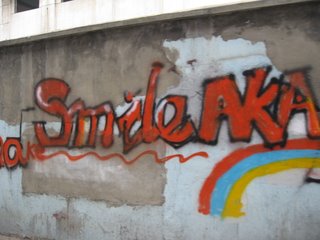
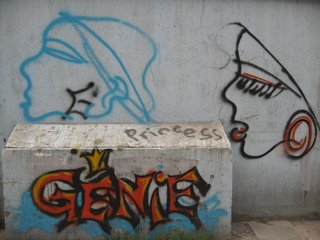
Nobody seems to know the place, even the cab driver. It's like a secret place in the city and this appeals to me very much. When we arrived at Moganshan Lu, this mysterious place begin to unveil itself: empty street, graffiti,wasted warehouse. But instead of being inanimate, it gives forth the smell of art. As we got closer, many art studioes and galleries appears.
Bizart
I like the name of "Bizart" very much. Davide gave us a very insightful lecture and explained the complication and something we don't know about art, like the forces of the government they have to face when organizing an exhibition. The following work is "a world can't be without electricity".
East link

East Link is a spacious place, and there are three rooms inside. They are pictures of experimental art of modern life, works reflected the Cultural Revolution, and a collection of wood furniture antiques respectively.
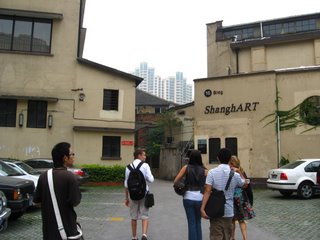 I think the Shanghart Gallery can be a representive of this art district. It is a typical warehouse with high ceilings, shabby walls. There are also many documentations of artists.
I think the Shanghart Gallery can be a representive of this art district. It is a typical warehouse with high ceilings, shabby walls. There are also many documentations of artists.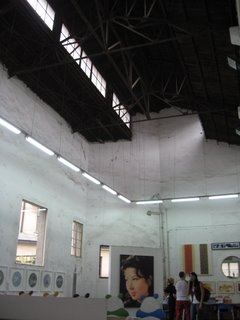
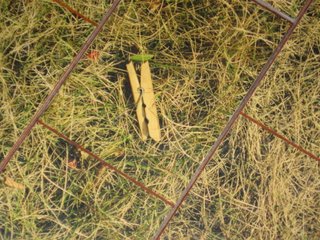
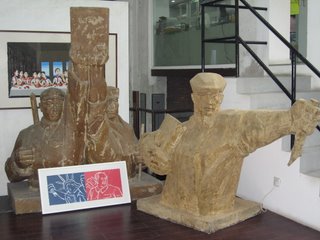
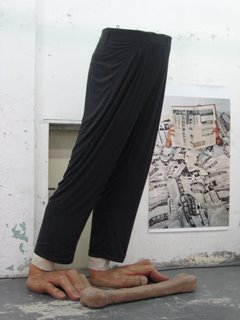
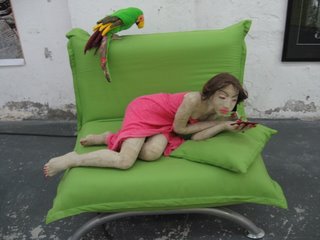

M50 is a very special art district where massed with many galleries and artists locating in large groups of depots. Regardless of the rubbishy street (old, dirty street, even the cab driver has not heard about)
 and the letter written by some person who used to live in the neighborhood to appeal that some land agent forced to occupied his house,
and the letter written by some person who used to live in the neighborhood to appeal that some land agent forced to occupied his house, M50 is a unique product of the new attitude and policy of the local government which reveals the contemporary art gradually blooming and merging into the culture and economy. Simple and crude houses can not conceal the gorgeous art works in them.
M50 is a unique product of the new attitude and policy of the local government which reveals the contemporary art gradually blooming and merging into the culture and economy. Simple and crude houses can not conceal the gorgeous art works in them. The whole area permeates the breath of art and the ropey wall better stand out the solemn and quiet atmosphere.
The whole area permeates the breath of art and the ropey wall better stand out the solemn and quiet atmosphere. Modern signs, logos and old depots and all kinds of arts, numerous inconsonant things form the entire M50,
Modern signs, logos and old depots and all kinds of arts, numerous inconsonant things form the entire M50, just like you haven’t stop memorizing the works in one gallery and then step into another art world. Outside the M50, more and more galleries and workshops are under construction, as MSG gallery. In the lecture given by Davide, I fundamentally understand the association between the art gallery, exhibition, museum and the government. The conversation totally breaks up my view of foreign artists in
just like you haven’t stop memorizing the works in one gallery and then step into another art world. Outside the M50, more and more galleries and workshops are under construction, as MSG gallery. In the lecture given by Davide, I fundamentally understand the association between the art gallery, exhibition, museum and the government. The conversation totally breaks up my view of foreign artists in 
 From the introduction book I learned that this gallery more focus on the association between science and art. Some of them are through accurate calculated, like the chair above, and this remind me the aim of MIT media lab, use kinds of modern technique to perform art. And the manager there is also big collector. There are so many interesting collections.Like this one
From the introduction book I learned that this gallery more focus on the association between science and art. Some of them are through accurate calculated, like the chair above, and this remind me the aim of MIT media lab, use kinds of modern technique to perform art. And the manager there is also big collector. There are so many interesting collections.Like this one Zeng Fanzhi is a very talent oil painter, from his works we can see he is pretty good at manifest lines, these clutter and delicate lines give us great imagination.Those are two pieces of his works.
Zeng Fanzhi is a very talent oil painter, from his works we can see he is pretty good at manifest lines, these clutter and delicate lines give us great imagination.Those are two pieces of his works.
